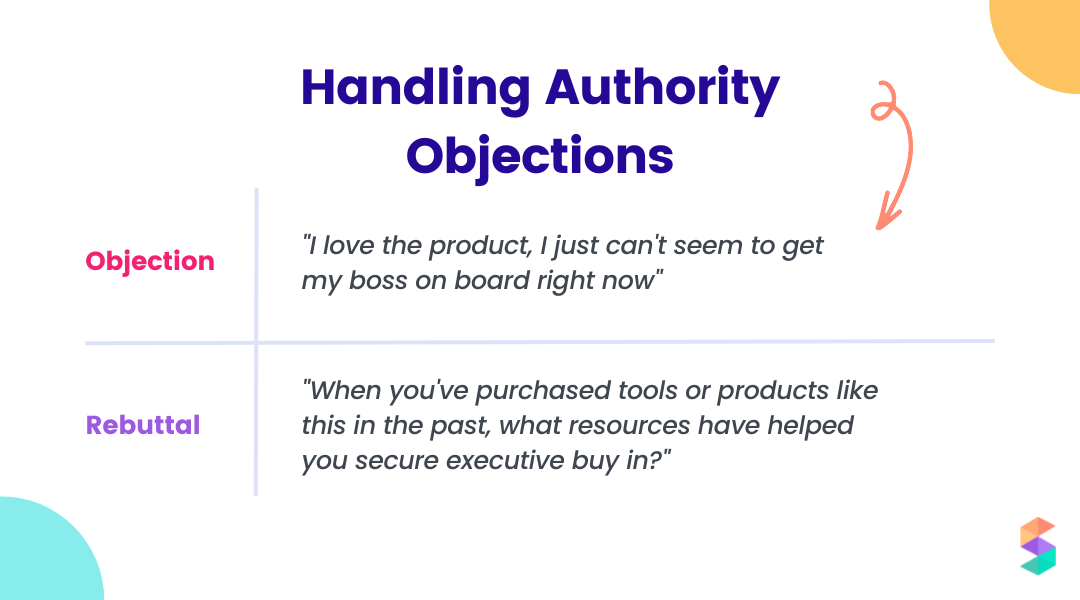Sales objections are a common occurrence during a typical sales cycle. Therefore, learning how to effectively handle objections is crucial to hitting goals, crushing sales quotas, and developing a successful sales career.
This blog post will discuss the most common sales objections and provide actionable tips on how to combat them. Whether you’re new to sales or a seasoned professional, today’s post is for you. With just a few tweaks, we’ll help you hone your objection handling skills, improve your sales performance, and hit your revenue goals.
Step 1: Get deeply acquainted with the prospect’s perspective
To handle sales objections effectively, sales professionals must have a deep understanding of the prospect’s perspective on both a macro and micro level– All before ever picking up a phone or drafting an email.
On a macro level, it’s important to understand the buyer personas that make up your target audience. This helps reps to better anticipate and field common objections each specific type of buyer may bring to the table.
Let’s look at an example. If you sell software to small businesses, you can anticipate and prepare for objections related to product complexity and pricing.
On a micro level, understanding each unique prospect’s perspective is equally important. Just because members of your buyer persona may share certain characteristics, each prospect is different. Do your due diligence and research each prospect’s company and potential pain points ahead of time. That way, you can confidently intercept prospect-specific objections in addition to the broader objections they may have.
Let’s look at another example. While reading your prospect’s Glassdoor reviews, you see several complaints about data silos and clunky tech stacks. Going into the sales call, you prepare to speak to both the usability of your product as well as its strong integrations.
Anticipating objections is key to sales success. By understanding the prospect’s perspective, sales reps can anticipate and address potential objections proactively, increasing the chances of closing each deal. Additionally, tailoring your responses to each prospect’s unique situation helps to build a stronger relationship and demonstrate a deeper understanding of their needs. Thus, building trust in your organization over time.
Recommended reading: Using a Sales Leaderboard to Motivate Your Team.
Step 2: Memorize this objection handling framework.
No matter how much research you do or how much time you spend digging up information on your target accounts, there will inevitably be times when you encounter an objection you’re not prepared to handle.
In times like these, it’s important to build habits that will allow you to think on your feet and give you the tools to adeptly handle objections on the fly. This framework will help you do just that:
Be an active listener.
Did you know that the best sellers have a “talk to listen” ratio of 46% and that for average sellers that same statistic skyrockets to the high 60% range (source)?
Listening is a vastly underrated skill when it comes to selling and objection handling in particular. But, here’s the thing, listening isn’t simply pausing midway through a cold pitch to see if your prospect has anything to contribute. If that’s your version of listening, it’s time to step it up.
Active listening is a communication technique that involves giving your full attention to the person speaking, not just hearing their words but also understanding their message, and showing that you are engaged in the conversation.
It involves focusing on the speaker, paying attention to their non-verbal cues, and asking relevant questions to clarify and understand their perspective. Active listening requires effort and concentration, but it helps build stronger relationships and improves communication in both personal and professional contexts.
In sales, active listening is a critical skill that allows sales representatives to understand the needs and concerns of prospects better, build rapport, and ultimately close more deals.
If you find yourself facing an objection you’re unprepared for, take a breath, ask clarifying questions to better understand the pain point, and engage your active listening skills. This will give you more information to work with and it will help you give more informed and engaged responses.
Confirm and acknowledge the objection
Confirming and acknowledging sales objections is an essential part of effective objection handling. Let’s look at how you can do this effectively to better address and overcome objections.
First, repeat and rephrase the objection. Start by acknowledging the objection in your prospect’s own words. This shows that you’re listening and that you care about the prospect’s concerns.
Then, rephrase the objection in your own words. This will help clarify any misunderstandings and ensure that you’re addressing the correct issue.
Here’s an example: “Okay, so you have concerns that our implementation times might prevent you from hitting your deadline that’s about six months away? That’s completely valid, Tom. To be clear, you feel like our software would take too long to deploy, is that accurate?”
Once you’ve confirmed you’re on the same page as your prospect, be sure to take it one step further and validate their concerns. This shows that you not only understand the issue, but you also understand why it’s an issue. This extra reassurance establishes the sales representative as an authority when it comes to understanding and solving problems of this nature.
Continuing with our example: “I understand this deadline is critical in the timeline of project XYZ and that missing it isn’t an option because that would prevent you from hitting board targets. This is something we work through regularly and I have several solutions in mind that might help speed up implementation to work within your timeline.”
Ask questions to better understand the objection
Questions are a great way to stay in control of the conversation while making the customer feel heard. In fact, asking 11 or more questions during a sales conversation has been shown to increase the likelihood that they become a customer by 74% (source).
Asking open-ended, high gain questions will help keep the conversation flowing while giving your prospect the opportunity to elaborate on their concerns and needs.
Once you’ve identified the underlying meaning behind the objection with the right questions, be direct in addressing that specific pain point for your buyer with evidence to ease their concerns.
Above all else, be helpful.
At the end of the day, handling objections comes down to how well you can provide the prospect with something of value. If you’re receiving an objection it means you haven’t yet done enough to prove the value of your product or service.
Although it’s easy to become defensive, shut down, or move on to the next deal at the first sign of an objection, it’s important that you fight these types of reactions. An objection isn’t a rejection, it’s simply an opportunity to provide more specific value that resonates with your prospect.
Step 3: Save this quick guide
Although objections come in all shapes and sizes there are a few tried and true objections sales reps report seeing most frequently. When all else fails, make sure you know how to handle the following types of sales objections:
Price Objections
Pricing objections are common, even in instances where the prospect has already decided to purchase your product. While some objections around price or budget are sincere, others may be an attempt at securing a discount. Either way, an objection around price doesn’t have to be the end of the road.
Let’s start by looking at what a price objection might sound like:
-
-
- “I’m interested in your product, but this price is much higher than what I expected.”
- “Your product seems interesting, but I’m not sure I can justify the expense right now.”
- “Your competitors’ pricing is much lower than what you’ve quoted us.”
- “We’re on a spending freeze right now and I don’t have the budget.”
- “Your price is too high for us right now.”
-
While pricing is a concern for organizations, what most prospects are really saying when they balk at the cost of your product, is that you haven’t yet proven the value. Therefore, in order to overcome a price objection, we recommend highlighting how your offering can save them money, increase their productivity, or help them achieve their goals.
Here are some prompts that might help you overcome pricing objections:
-
-
- “What would a product have to offer you or do in order to be worth this price?”
- “If you don’t purchase our product, how would you solve XYZ problem?”
- “I understand your concern, we know there isn’t a lot of budget to spare right now, but companies like yours have found that using this product has saved them 30 hours of work a month. They use that additional time for revenue generating activities.”
- “Our competitors do offer lower pricing but we’ve seen an uptick in the number of companies moving from their software to ours due to the missing ABC functionality and additional expenses in lost productivity.”
- “Would it be helpful to see case studies we’ve done with companies similar to yours? They’ve achieved really great outcomes with the help of our product and we think you can too.”
-

Remember, pricing objections are common, but they don’t have to be deal-breakers.
Timing Objections
Another common objection is around timing. These may come in a range of statements.
-
-
- “Try back next quarter.”
- “Your product seems interesting but not a priority for us right now.”
- “We see the benefit of your product but the timing isn’t right.”
- “We have other priorities right now.”
- “We don’t have the manpower or bandwidth right now.”
-
A timing objection isn’t always as straightforward as a pricing objection. A pricing objection usually means you haven’t proven the value. But, a timing objection could mean a few different things. Let’s unpack the most common hidden meanings behind timing objections.
-
-
- The project or initiative has been deprioritized.
- The prospect feels like they have a lot of leg work to do before they can use a solution like yours- data clean up, strategy overhaul, hiring, training, etc.
- You haven’t created enough sense of urgency.
- You haven’t equipped your prospect to sell the product or solution internally.
-
The best way to figure out the meaning behind the objection is to ask. Try questions like these:
-
-
- “Have your priorities changed since our last conversation?”
- “If this project is no longer a priority, can I ask what is at the top of your priority list?”
- “When do you anticipate this will become a priority?”
- “Is there anything I can do to help you sell this better internally?”
- “What would have to happen or change for this to be your number one priority?”
-
Once you do some digging and get to the root of the problem you can address the issue at hand. This may include sharing insights and resources to create a sense of urgency, arming the prospect with resources to make the sale internally, or by better communicating the value of your product or service.

Recommended reading: The Sales Leader’s Guide to Using Mutual Action Plans.
Product Fit/Need Objections
This third type of objection happens when the prospect believes they don’t need your product or that it won’t work for them. Although there are many circumstances where a prospect may not be a good fit for your product, a lot of times, product fit/need objections stem from a misunderstanding or miscommunication.
Here’s what a need objection may look like in the wild:
-
-
- “Your product won’t help me with X, Y, or Z”
- “Your product is interesting but it’s pretty low on my list of “must-haves” right now.”
- “I don’t see how your product is going to help me.”
- “This isn’t going to simplify my process or make my job easier.”
- “Why would I need this? My current process works for me.”
-
A product fit/need objection is a symptom of a larger issue with the communication between sales rep and prospect. Here’s what this type of objection really means:
-
-
- You didn’t do enough research on the prospect to understand their true pain points.
- You didn’t frame the value of your product in a way that speaks to the core responsibilities of this prospect.
- You didn’t communicate value, period.
- You haven’t communicated the time savings, ROI, or benefit in terms that resonate with your potential buyer.
-
Instead of simply accepting defeat, it’s important to dig deeper to see whether or not the prospect’s objection is based on a fair assessment of your product or solution. Here are some prompts to get you started:
-
-
- “I’d love to understand more about the problems you’re trying to solve. What is a problem you deal with that, if solved or eliminated, would change the quality of your life?”
- “What would you say your biggest struggle is right now?”
- “What feature would we have to add or change about our product to make this more of a priority for you?”
- “What would you change about your current process?”
- “What would you say your team’s biggest priority is this year?”
-

While you’ll always encounter circumstances where it makes sense to disqualify a prospect, often you’ll find that more open communication leads to more productive discovery.
Competitive Objections
Unlike the other objections we’ve covered so far, there is a small upside to a competitive objection. Someone evaluating or even working with your competition has already established a need for a solution like yours and likely has a dedicated budget set aside.
Here are some common ways a prospect might voice a competitive objection:
-
-
- “We already use XYZ for that.”
- “Right now your competitor is our vendor of choice.”
- “XYZ product quoted us a much lower price.”
- “XYZ product seems easier to use/has shorter implementation times/offers professional services.”
- “Your product seems superior, but we don’t want to deal with the hassle of switching vendors.”
-
When dealing with competitive objections, you can skip past the more open-ended discovery questions around value, priorities, and pain points and ask more direct questions and clarify any misconceptions the prospect may have about your product. Try one of these:
-
-
- “If you could change anything about product XYZ what would it be?”
- “What is your team’s biggest struggle with XYZ product?”
- “A large number of companies like yours have switched from product XYZ to our product in the last few months for reason XYZ. I would be happy to put you in touch with one of these customers so you can learn more about their experience.”
- “Which vendor is currently in the lead right now? And, what is it about them you prefer?”
- “Would you be open to learning more about how companies like yours see a higher ROI after switching to our product?”
-

When facing competitive objections, you will inevitably come up short sometimes. That’s just the nature of the job. But, doing your due diligence and digging into the prospects’ decisions will help to ensure you don’t leave money on the table unnecessarily.
Authority/Buying Committee Objections
In some instances, your prospect will be an enthusiastic champion of your product or service throughout the entire sales process. Until, one day, seemingly out of nowhere, they hit you with an authority/buying committee objection. Here’s what this might sound like:
-
-
- “I love the product, my boss just doesn’t think it’s a priority right now.”
- “I see the value but my team doesn’t think it’s important”
- “Unfortunately our executive won’t sign off on the contract until he understands more.”
- “This is on hold until I can present our options to the higher ups.”
- “My manager wants to widen our pool of potential vendors before we make a final decision.”
-
The underlying reason behind an authority objection is usually about making a business case to their boss or other final decision makers. The best way to handle this is to get clarity on the prospect’s buying process, and then develop a strategy together to arm your prospect with the resources they need to make a stronger case.
Here are some prompts to keep the conversation going with a prospect who’s hit you with an authority/buying committee objection:
-
-
- “When you’ve purchased tools or products like ours in the past, what resources have helped you gain executive buy in?”
- “You know your management team better than I do. What is it they care about most when it comes to buying newtech?”
- “Who else on your team cares about solving this problem? Should we pull them into the conversation at some point?”
- “How can I help you champion our product internally?”
- “What kinds of issues or questions do you anticipate your manager having?”
-

In these circumstances, it’s all about helping your prospect help you. You are both focused on the same outcome. Treat the prospect like a partner and not an adversary.
Step 4: Always leave the door open for future conversations.
No matter how much value you offer and how well you respond to objections, at a certain point, it’s important to read the room and know when to take no for an answer. Remember, selling is all about building relationships based on a foundation of trust and helpfulness. This means respecting boundaries, picking up on social cues, and knowing when enough is enough.
While rejection is often part of the job, it’s not always a dead end. When you reach the end of a sales cycle and the outcome is a loss, we recommend always leaving the door open for future conversations. This means prioritizing the relationship with the prospect rather than prioritizing the win. If you continue to engage with the prospect and continue to be a resource to them, you’ll find it’s easier to gain their respect and win them over in the long run.
So what does this look like in practice? Here are a few examples:
- Connect with the prospect or buying committee on LinkedIn and meaningfully engage with the content they post. Ask questions, recommend resources, and be supportive.
- Keep the prospect in the loop when your company updates their offering or makes enhancements to existing features. Keep it light and don’t be pushy. Frame your updates as a helpful FYI rather than a continued push to make a sale.
- Keep notes and remember your conversations with them. Let them know when something reminds you of them or share an inside joke without any ties back to your product or service.
At Spiff we believe in repeated games. If you pout or handle rejection poorly or even worse, take your frustrations out on the prospect, you’re only damaging your future self.
Recommended reading: The ROI of Losing: Rethinking Loss in Sales
Final Thoughts
Overcoming sales objections is important, especially during times of economic crisis or recession. Your buyers are facing pressure within their own businesses and budgets are tighter than ever before.
While it may feel impossible to overcome objections in times like these, it’s important to also look at it as an opportunity to alleviate pressure, increase productivity, and make your prospect the hero.
Leading with empathy and understanding will not only help you understand where most objections are coming from, but it will also help to build trust in your product and organization. Mastering these skills can ultimately lead to more closed deals, revenue, and loyal customers.
Give this framework a shot and let us know what you think! We’d love to know which objection handling techniques have worked for you.
Recommended reading: The Definitive Guide to Recession-Proofing Your Sales Organization
About Spiff
Spiff is a new class of software that creates trust across the organization by delivering real-time automation of commission calculations and motivates teams to drive top-line growth. With a combination of an intuitive UI, real-time visibility, and seamless integrations into current systems, Spiff is the first choice among high-growth businesses. Spiff’s sales commission software enables finance and sales operations teams to self-manage complex incentive compensation plans and provides transparency for sales teams.






